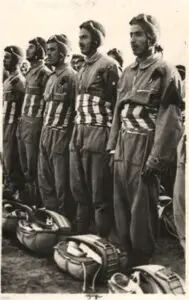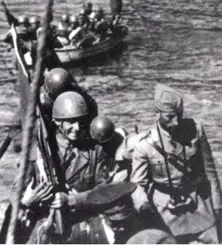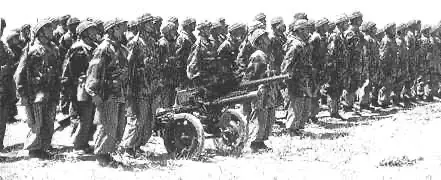From the first experiments with parachutes to the first airborne division, this is the story of the Italian paratroopers in WW2
Origins
The Italian armed forces started to experiment with the use of parachutes in military operations already in the first World War. In august 1918, Lieutenant Alessandro Tandura was parachuted behind the Austro-Hungarian lines and carried out intelligence and sabotage operations for four months, until the end of the war. He was the first man in the world to use the parachute not as an escape device but for tactical purposes. After the end of the war, the tactical use of the parachute was abandoned, focusing instead on its original purpose as a safety device for pilots of the emerging Regia Aeronautica. In the 1920s and 1930s parachute devices were developed and refined, giving birth to the “Salvator” D.37 and D.39 models. These devices equipped the aircrews of the Regia Aeronautica but soon they would have to find another use.
The Libyan paratroopers
In March 1938, Italo Balbo, Governor of Libya and former head of the Regia Aeronautica, established the Paratrooper school of Libya (Campo Scuola Paracadutisti della Libia). The objective was to develop and train a rapid reaction force, to be used against local guerrilla fighters. The Italians were familiar with insurgencies in Libya and Ethiopia and were trying to find new ways to address the problem (one being the establishment of the Italian African Police corp). In April, the 1° Regiment Fanti dell’ Aria (Air infantrymen) was established, listing 300 men, mostly Libyans from the colonial divisions led by Italian officers. The regiment was subsequently dismantled and only the 1st Battalion Fanti dell’ Aria remained, together with the “National” Paratrooper battalion, formed by Italian volunteers.

Libyan paratroopers (Military History)
These units saw action during Operation Compass and were used as elite infantry in rear-guard and breakthrough actions during the bloody withdrawal of the Italian 10th Army across Libya, between December 1940 and February 1941. The two battalions suffered heavy casualties, with 184 KIA (81 Italians and 103 Libyans) and 244 wounded, and by February had ceased to exist. Some survivors of the National paratrooper battalion were repatriated and later joined the ranks of the Folgore Division.
The Italian paratroopers
In October 1939, a second paratrooper school was established, this time in mainland Italy, near Tarquinia (not far from Rome). Training for instructors began in March 1940 while in July the first batch of “cadets” arrived, forming a total of three battalions. The training period began, sadly obscured by some mortal accidents during the launches. These accidents led to the development of a new and safer parachute (I.F. 41 S.P.). In addition, new pieces of equipment were refined. These included the paratrooper helmet, the knee pads and a special paratrooper boot.
Launch over Kefalonia
At the end of April 1941, the Italian paratroopers got their chance to make a launch during a military operation. In that period, Greece was on the brink of collapse and the first German units were entering Athens. On the 30th of April, 73 paratroopers of the 2nd Battalion, led by Major Zanninovich, were parachuted over the Ionian island of Kefalonia, aided by other units disembarked from CANT Z.506 seaplanes. The occupation of the island was completed with no shots fired and in the following days, the paratroopers occupied the nearby islands of Zante and Itaca.

Men of the Folgore during the operations in Kefalonia
The Battle of Eluet el Asel
In July 1941, the first paratrooper battalion “Tuscania” (made up by Carabinieri) completed the training and its 400 men were sent to North Africa, led by Major Edoardo Alessi. Contrary to their expectations, these men were never employed in parachute operations but instead were used as elite light infantry.
The paratroopers saw intense action during Operation Crusader, the Commonwealth offensive aimed at relieving Tobruk and destroying the Axis tank force in Libya.
The 1st paratrooper Battalion participated in the final phase of the massive clash when the Axis forces began their retreat towards Bengasi. On the 18th of December, the battalion deployed its men and six 47mm antitank guns at the crossroad of Eluet el Asel. They were ordered to hold the position as long as they could to allow the orderly withdrawal of the Axis forces. On the 19th Scouting units of the British 8th army were initially repelled but soon came an artillery barrage followed by tanks and more infantry. The paratroopers fought for the entire day but they became surrounded by the evening. With the cover of darkness, the bulk of the Battalion stormed the enemy lines hoping to break the encirclement. The manoeuvre was successful and Major Alessi withdrew with his men, except for a group of 40 that remained at Eluet el Asel to cover their comrades. When the battalion reached the Axis lines, the survivors were only 118 out of the initial 400, 251 were missed in action, and 31 killed.
Malta and North Africa (1942)
After the operations in the Aegean and North Africa in 1941, 6 new battalions with fresh recruits were formed. The objective was to train and equip a full Paratrooper division. In winter 1941, the Italian high command began to study a new plan for the invasion of Malta, which envisaged the role of paratrooper units. As consequence, the paratrooper training was accelerated, and the 9 battalions received the best equipment available. At the beginning of 1942, the paratrooper units became part of the 1st paratrooper division. In spring 1942, the division moved to the southern region of Puglia, for a final phase of training in preparation for Operation C3 (the invasion of Malta). The events of the summer of 1942 changed the Axis plans and the scheduled invasion never took place.
On the 13th of July 1942, came a new order; the division had to move to North Africa. Here, the division was deprived of its launching equipment and renamed 185th Infantry division “Folgore”. By the end of the month, the Folgore had reached the frontline and later took part in the battle of Alam Halfa.

Men of the Folgore division
The most famous engagement was the Folgore division took part was the battle of El Alamein, fought between the 23rd of October and 6th November 1942. The Folgore held its position in the southern sector of the Axis deployment and the first days of the attack, repelled all the breakthrough attempts, at the cost of heavy casualties.
From the 26th of October, the frontline remained calm while the Allies were redirecting their efforts towards the north. On the 1st of November, the 8th army launched Operation Supercharge and achieved a breakthrough in the northern sector. On the 2nd of November, most of the Axis units began their withdrawal towards a new defensive line. Italian infantry, including the Folgore, had to move on foot, due to the lack of transport; as consequence, several columns were captured by mobile British units. On the 6th of November, the remnants of the Folgore were attacked by the 1st British armoured division. The paratroopers improvised a defensive perimeter with the few remaining antitank guns and rifles. They fought for the entire morning and when all ammunitions were exhausted, the last survivors of the Folgore (a few hundred men) surrendered to the British.
Sources
Ciavattone, F. (2022). PARACADUTISTI! Storia delle Aviotruppe Italian. STORIA MILITARE Dossier n.61.
Jowett, P. (2019). L’esercito italiano nella seconda guerra mondiale. LEG edizioni.
Santangelo, A. (2020). La battaglia di El Alamein. Il Mulino.
